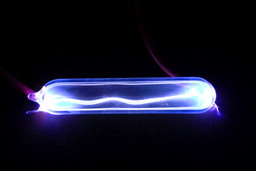Dielectric protected regenerable vacuum ultraviolet lamp
TECHNOLOGY NUMBER: 2023-250

OVERVIEW
An improved design for vacuum ultraviolet (VUV) lamps- Extends the operational lifetime of argon VUV lamps to 1,000+ hours (10x improvement)
- Protects lamp windows from both exterior and interior causes of degradation
BACKGROUND
Vacuum ultraviolet (VUV) lamps are widely used in many applications, including for ionization of gas phase molecules in gas analysis and detection. VUV lamps emit through a window, which must be transparent to the high-energy, short-wavelength photons created by the plasma inside the lamp. Typical VUV window materials are susceptible to degradation and the formation of color centers, which are caused by exposure to exterior moisture, highly energetic species within the lamp, and VUV photons. Due to transparency requirements of particularly high energy lamps, such as argon VUV lamps, LiF must be used as the lamp window material. Unfortunately, LiF is particularly susceptible to moisture and color center formation. While a MgF2 window may withstand a few thousand hours of operation, a LiF window typically lasts only about 100 hours. This makes argon VUV lamps very expensive and their lifetime notoriously short.
INNOVATION
Researchers at the University of Michigan have developed a VUV lamp design that protects the LiF window from exterior moisture as well as the ions, electrons, and excited-state gas molecules within the lamp chamber. The protective coatings increase lamp lifetime by 10x while maintaining LiF's excellent VUV transmission properties (60-70% for photons with energies from 8.5 to 11.5 eV). The design avoids the many shortcomings of alternative approaches based on thin metal films. An added benefit is that the coating of the UM design may be regenerated using a secondary, deep UV (DUV) light source and/or a heat treatment. This technology is suitable for any VUV lamp (krypton, xenon, e.g.) and is particularly desirable for argon lamps, with their very high energy photon emissions. The coating may be applied by any microfabrication process for dielectric deposition, such as plasma-enhanced chemical vapor deposition (PECVD), sputtering, or atomic layer deposition (ALD).